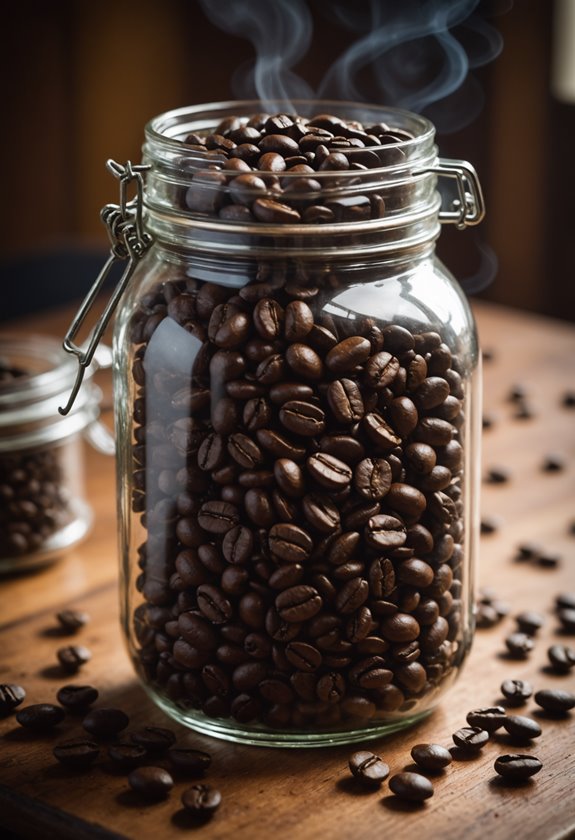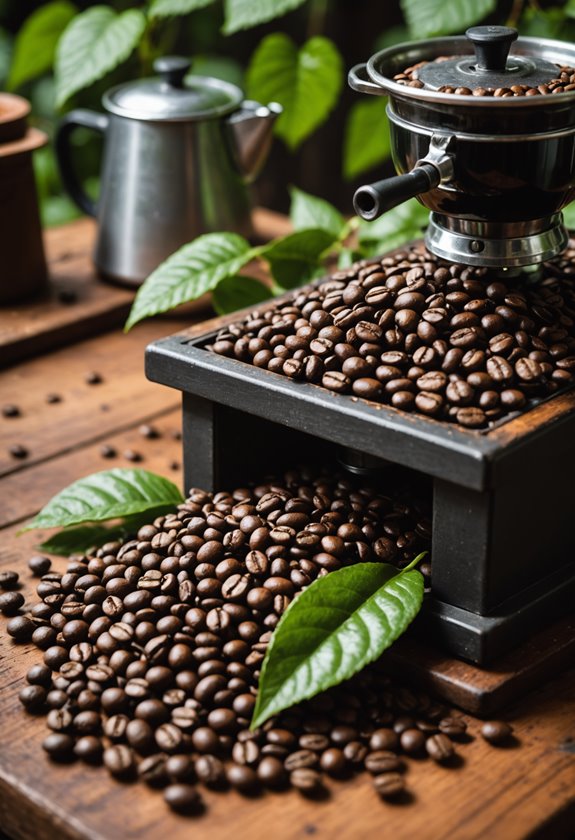What to Do After Roasting Coffee Beans?
After roasting coffee beans, you'll want to let them rest to enhance their flavor; this allows carbon dioxide to escape. For lighter roasts, rest them for up to 7 days, while darker roasts need about 1-3 days. During the first 12-24 hours, keep the container's lid slightly loose to let gas safely release. Once cooled, store your beans in airtight containers with one-way valves in a cool, dark place to preserve freshness. For lasting quality, note the changes in flavor over days. Let's investigate how tasting your roasted coffee regularly will deepen your understanding and enjoyment.
Key Takeaways
- Cool the coffee beans completely to avoid moisture and stale flavors.
- Rest the beans 12-24 hours with a slightly loose lid for degassing.
- Store in airtight containers at room temperature in a cool, dark place.
- Regularly taste the beans to monitor and document flavor development.
- Grind the beans just before brewing to maintain optimal freshness and flavor.
Resting Your Coffee

After you've roasted your coffee beans, it's important to let them rest for a while to achieve the best flavor. Resting freshly roasted beans allows carbon dioxide to escape, which is significant for enhancing how your coffee tastes. This rest time varies depending on the roast level; lighter roasts might require up to 7 days, while darker roasts are usually good after 1 to 3 days.
Understanding Rest Time
Let's examine why this process is important. As your beans rest, carbon dioxide, a byproduct of roasting, gradually escapes. This degassing is essential, as too much CO2 can impact flavor negatively.
During this period, you should store coffee beans at room temperature in a sealed container. However, for the first 12-24 hours, you might leave the lid slightly loose to facilitate gas release.
Daily Tasting Experience
While your beans rest, engage in daily tastings to appreciate the changing flavors. This practice helps you pinpoint when your beans hit their best flavor.
You'll notice how different roast levels affect flavor maturity over time.
Using a popcorn popper method can help achieve consistent results when roasting your own beans at home.
Proper Storage Techniques
Storing your roasted coffee beans properly is essential to preserving their flavor and freshness. After roasting, let your coffee beans cool completely before transferring them to storage. This step prevents moisture buildup, which can compromise the beans' flavor integrity.
Use airtight containers to keep your roasted coffee fresh. Containers with one-way valves are ideal because they allow carbon dioxide to escape without letting air in, minimizing oxygen exposure that leads to staleness.
Choosing the Right Storage Location
Place your storage containers in a cool, dark place. Light, heat, and humidity can all negatively affect the freshness and flavor of your coffee. By protecting your beans from these elements, you maintain their quality over time.
Short-term vs. Long-term Storage
For short-term storage, consider using mason jars or valve bags. If you're thinking long-term, vacuum-sealing or freezing the beans in single-serving portions is a smart move. This helps maintain their quality and freshness for extended periods.
Grinding Just Before Brewing
Always grind your coffee just before brewing. This approach reduces the surface area exposed to oxygen, helping retain the coffee's rich flavor for a longer time. Leaving beans exposed to air for even a few hours can result in significant loss of essential oils and aromas.
Let's investigate these techniques to enjoy your coffee at its best.
Tasting for Flavor Development

Once you've verified your roasted coffee beans are stored properly, it's time to examine how their flavors develop over time. Tasting fresh roasted beans at different stages of their resting period is key to understanding how the flavors and cup quality evolve.
Start by allowing the roasted coffee to cool to a comfortable tasting temperature, ideally between 50-65˚C.
Let's investigate some steps to guarantee a thorough tasting process:
- Taste coffee at intervals: Sample the resting coffee over 1 to 14 days. This helps you track how the flavors change and when peak quality emerges.
- Brew coffee consistently: Use the same brewing method each time. This guarantees that any flavor differences come from the coffee itself, not brewing variables.
- Focus on details: Pay attention to mouthfeel, texture, and aftertaste. These elements reveal much about the coffee's flavor complexity and overall quality.
- Record your findings: Keep detailed notes on the flavors and aromas you experience. Compare these with coffee labels and other references to deepen your understanding.
Managing Freshness and Quality
Properly managing the freshness and quality of your roasted coffee beans is vital for enjoying their best flavor profile. After roasting, let your coffee beans cool completely. This significant step prevents moisture buildup and stale flavors, ensuring a fresh product.
Once cooled, allow them to rest after roasting during a degassing period of 12 to 24 hours. By loosely sealing storage containers, you enable carbon dioxide to escape, enhancing flavor development.
To preserve freshness, store freshly roasted coffee in airtight containers. Keep these containers in a cool, dark place, away from light, moisture, and temperature extremes. This method maintains their quality for up to 4-6 weeks.
Remember, regularly checking moisture levels in storage areas is important. Ensuring containers are moisture-resistant helps prevent degradation of your coffee's quality.
When it's time to enjoy your coffee, grind just before brewing. Grinding increases the coffee's surface area, which accelerates staling. By grinding right before use, you uphold ideal freshness and flavor.
Let's investigate these practices to keep your roasted coffee at its peak, savoring every cup with the finest taste your beans have to offer.
Many coffee enthusiasts use popcorn poppers as an affordable entry point into home roasting.
Exploring Home Roasting Benefits

While managing the freshness and quality of your roasted coffee beans is key, investigating home roasting benefits offers an exciting adventure for coffee enthusiasts.
Understanding roasting stages carefully ensures optimal flavor development in your beans at home.
Home roasting allows you to enjoy fresh coffee customized precisely to your taste preferences. You can experiment with roast time and flavor profiles, creating roasted coffees that match your palate.
Here's why diving into home roasting is worthwhile:
- Personalized Flavor: By controlling roast time, you can achieve specific flavors that you love, whether you prefer the bright acidity of Costa Rica beans or the chocolatey tones of another origin.
- Freshness: Enjoy coffee at its peak freshness, particularly on the first day and immediately after roasting, when flavors are most lively.
- Learning and Adjustment: With each roast, you'll document results, enabling you to make adjustments for the next batch. Tools like the IKAWA Home app can help refine your skills.
- Community and Connection: Home roasting nurtures a deeper connection to coffee, encouraging shared knowledge and continuous improvement among enthusiasts.
Let's investigate this adventure, where making coffee is an option that's both educational and rewarding.
Accept the process and watch your understanding of coffee grow with each roast.







